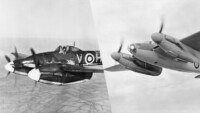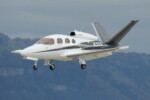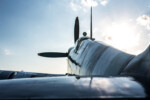The Best British Fighter Planes of WW2
30 June 2022 | Updated on February 05, 2024
Soaring through the skies of WW2, the British fighter planes etched a saga of defiance, delivering the first punch to the undefeated Germans. These very planes, which many considered relics at the war’s onset, were the unsung heroes that paved the way for the monumental Normandy offensive, tilting the scales towards the Axis surrender.
It’s nothing short of astonishing when you consider that many of the Royal Air Force’s fighters were seen as outdated underdogs against the menacing might of the cutting-edge Luftwaffe fighters. Yet, these determined “underdogs” danced in the skies of Europe, Africa, and the icy Northern Atlantic, clinching victories in some of the most pivotal aerial showdowns of the war.
The Battle of Britain, fought over the scenic landscapes of Southern England, stands as a testament to their valor. Here, the British pilots, although outnumbered, outgunned, and seemingly outmatched, brought down entire Luftwaffe squadrons, eradicating the looming specter of a German invasion. It’s a tale of grit and glory, where the old guard met the new wave and emerged triumphant.
The Best British Fighter Planes of WW2
Dive into the tales of the magnificent machines that ruled the skies during WW2, defending their homeland and rewriting the annals of aerial warfare. Welcome to the legends of the best British fighter planes of the Second World War.
9. Westland Welkin
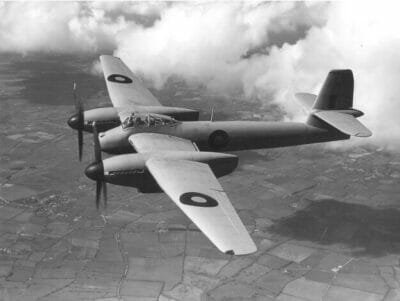

The Westland Welkin is a twin-engine high-altitude heavy fighter designed to counter the threat of Luftwaffe’s high-altitude bombing raids over England. Welkin means ‘vault of heaven,’ identifying the aircraft’s high-altitude flight capabilities, and it was one of the fewest British fighter planes ever produced. The Westland Welkin aircraft was modeled after the twin-engine Whirlwind fighter plane but was equipped with bigger Rolls Royce Merlin 76/77 engines and a pressurized cabin. Engineers made extensive changes to the cockpit design to enable the Welkin to perform high-altitude operations. These involved using a heavy-gauge aluminum construction with a thick inner perspex layer to withstand the high pressures of stratospheric flight conditions.
Additionally, Westland Aircraft installed a Rotol supercharger to the port side engine, pumping heated air between the two cockpit layers to prevent frost from forming on the cockpit canopy. Still, pilots were required to wear a rubber oxygen mask during flight. The threat the Welkin fighter was conceived to counter did not occur, and very few production aircraft left the factory.
Aircraft details
- Manufacturer – Westland Aircraft Limited
- Introduction – 1944
- Role – High-altitude fighter and interceptor
- Configuration – Twin-engine, single-seat
- Engine – 2 x Rolls Royce Merlin Mk.76/77 engines, 1,250 hp each
- Speed – 623 kph (385 mph, 334.5 kn)
- Range – 2,400 km (1,500 mi, 1,303 nmi)
- No Built – 77
8. Boulton Paul Defiant
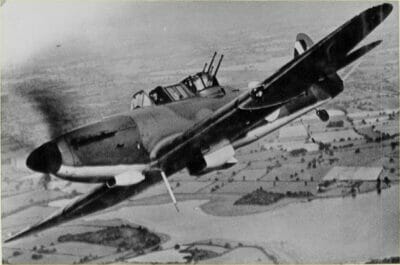

The Boulton Defiant is a twin-seat British fighter plane of WW2 with a power-controlled non-forward facing four-gun turret enabling it to engage enemy aircraft from behind. It excelled at its primary role, hunting and shooting down unescorted Luftwaffe bombers. But their lack of forward-facing guns made them vulnerable against the faster and highly maneuverable German fighters, including the Messerschmitt Bf 109 fighter plane. However, the Defiant was most effective as a night fighter and was responsible for engaging and downing more enemy bombers than any other British military aircraft during the London Blitz between 1940-41. By 1942, the RAF had replaced its Boulton Defiant fighters with more capable Bristol Beaufighters and de Havilland Mosquito night fighters.
Aircraft details
- Manufacturer – Boulton Paul Aircraft
- Introduction – 1937
- Role – Fighter aircraft, interceptor
- Configuration – Single engine, two-seat
- Engine – 1 x Rolls Royce Merlin III liquid-cooled V12 engine, 1,030 hp (770 kW)
- Speed – 489 kph (304 mph, 264 kn)
- Range – 748 km (465 mi, 404 nmi)
- No Built – 1,064
7. Bristol Type 156 Beaufighter
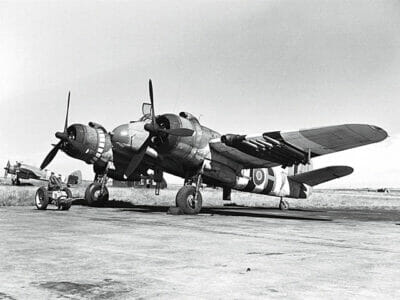

The Type 156 Beaufighter, known as “beau,” is a twin-engine night fighter with extensive multirole capability. It was manufactured in England and Australia and debuted with the RAF during the Battle of Britain. The Beaufighter’s large fuselage allowed it to carry large amounts of ammunition and aircraft radar detection equipment without compromising performance. It was one of the most capable British fighter planes at its introduction, and it was conceived as a long-range fighter aircraft designed to deploy heavy payloads to achieve maximum effect. To accomplish its mission, the Beaufighter was fitted with a pair of powerful and efficient Hercules engines with noise reduction technology which led Japanese soldiers to nickname the aircraft “whispering death” The Beaufighter saw combat service in almost every World War II war theater and was used in a variety of roles including ground interdiction and anti-shipping operations. Operators of the Beaufighter include Royal Air Force, Royal Canadian Air Force, Royal New Zealand Air Force, South African Air Force, The Free Polish Air Force, and United States Army Air Forces.
Aircraft details
- Manufacturer – Bristol Aeroplane Company
- Introduction – 1939
- Role – Heavy fighter, strike aircraft
- Configuration – Twin-engine, two-seat
- Engine – 2 x Bristol Hercules XVII or Bristol Hercules XVII 14-cylinder air-cooled sleeve-valve radial piston engines, 1,600 hp (1,200 kW)
- Speed – 510 kph (320 mph, 280 kn)
- Range – 2,820 km (1,750 mi, 1,520 nmi)
- No Built – 5,928
6. Westland Whirlwind
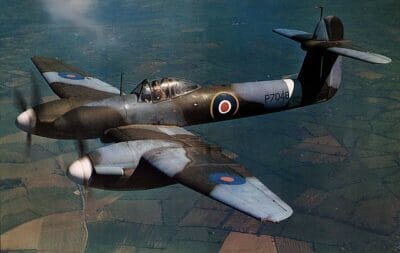

The twin-engine Westland Whirlwind was the fastest fighter plane in the world when it was launched in 1938. It was one of the most celebrated British fighter planes of World War 2, alongside the Supermarine Spitfire and the Hawker Hurricane. The Whirlwind featured a rugged airframe construction protecting pilots during crash landings, and the location of the twin Rolls Royce engines shielded pilots from shrapnel and explosion debris during combat. To fulfill its primary role as a heavy fighter, the Whirlwind was equipped with four nose-mounted Hispano-Suiza HS.404 20 mm cannons firing explosive ammunition capable of destroying locomotives and German E-boats operating in the English Channel. The Whirlwind saw combat service in various multirole operations, including bomber escort, ground attack missions on military installations, railway traffic, and marshaling yards. Serious issues with the Rolls Royce Peregrine powerplants greatly impacted its ability to perform to its intended potential resulting in low production numbers before its eventual withdrawal by the RAF in 1943.
Aircraft details
- Manufacturer – Westland Aircraft Limited
- Introduction – 1940
- Role – Heavy fighter
- Configuration – Twin-engine, one-seat
- Engine – 2 x Bristol Hercules Peregrine I V-12 liquid-cooled engines, 885 hp (660 kW) each
- Speed – 580 kph (360 mph, 310 kn)
- Range – 1,300 km (800 mi, 700 nmi)
- No Built – 114
5. Hawker Tempest
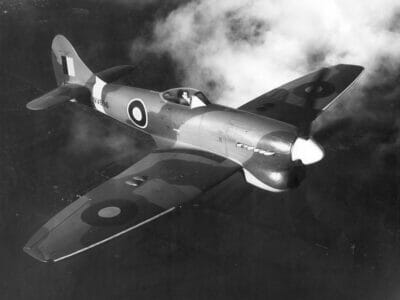

The single-engine Hawker Tempest is a low-altitude British fighter plane of World War 2 derived from the Hawker Typhoon. It featured improved wing design and more powerful engines making the Tempest one of the fastest low-altitude British fighter planes of the war. It featured a three-piece windscreen providing pilots with excellent visibility, a bullet-resistance center panel, four 20 mm cannons, and a range-extending 45-gallon fuel drop tank. It was introduced during the latter stages of WW2 performing armed reconnaissance missions behind enemy lines and ground attack support roles while successfully engaging more advanced German aircraft in aerial dogfights. The Tempest was the first fighter to shoot down a jet fighter, a Heinkel He 162, in combat. And it received massive acclaim for shooting down more than six hundred German V-1 flying bombs destined for civilian targets in England.
Aircraft details
- Manufacturer – Hawker Aircraft Limited
- Introduction – 1944
- Role – Fighter aircraft
- Configuration – Single-engine, one-seat
- Engine – 1 x Napier Sabre IIB H-24 liquid-cooled sleeve-valve piston engine, 2,420 hp (1,800 kW)
- Speed – 700 kph (435 mph, 378 kn)
- Range – 680 km (360 mi, 420 nmi)
- No Built – 1,702
4. Gloster Meteor
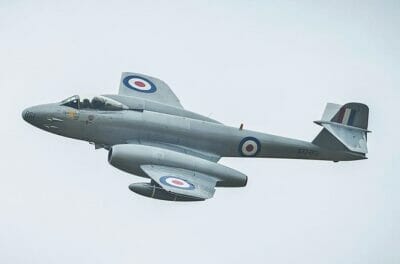

The Gloster Meteor is one of the most underrated British fighter planes of World War 2. Britain’s first jet fighter was the only Allied Jet fighter deployed for combat operations during the Second World War. On the runway, the twin-engine fighter looked like a conventional twin-engine military fighter plane. But glancing at the pair of the wing-mounted streamlined engine pods housing its Rolls Royce Derwent 8 turbojet engines will tell you this is no ordinary airplane. The Meteor revolutionary turbojet power plants were the brainchild of Power Jets Frank Whittle, an inventor, engineer, and RAF pilot. Its airframe features a modular airframe construction consisting of 5 different sections, and each section can be transported separately. As expected, the Gloster Meteor broke numerous aviation records setting new speed and climb records almost every year.
The Meteor’s combat duties were severely hampered by its limited fuel range and valid fears of captured aircraft falling into German hands. However, the exceptional performance of the advanced jet fighter led to more significant operational roles, and Meteor squadrons were based on European soil by the war’s end. Meteors served in several post-world war conflicts like the Korean War and the Israeli campaigns. However, its role as a frontline combat jet was gradually supplanted by newer and faster jet fighters sporting swept wings and better technology.
Aircraft details
- Manufacturer – Gloster Aircraft Company
- Introduction – 1944
- Role – Fighter aircraft
- Configuration – Twin-engine, one-seat
- Engine -2 x Rolls Royce Derwent 8 centrifugal flow turbojet engine, 3,600 lbf (16 kN) thrust each
- Speed – 970 kph (600 mph, 520 kn)
- Range – 970 km (520 mi, 600 nmi)
- No Built – 3,947
3. De Havilland DH.98 Mosquito
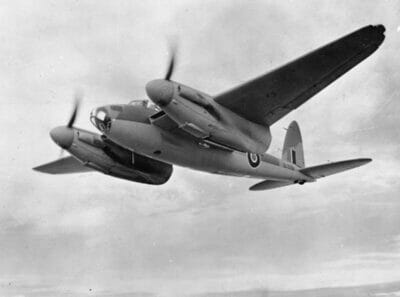

Ironically, one of the best British fighter planes of World War 2 was initially developed as a bomber which was visible in its massive dimensions. The de Havilland DH.98 Mosquito is a multirole twin-engine combat aircraft powered by a pair of powerful shoulder-mounted Rolls Royce Merlin 76/77 engines. It featured an unusual wood airframe, hence its nickname “Wooden Wonder” and “Mossie.” The Mosquito served many roles in every conflict theatre throughout the war and performed several vital missions, including precision strikes at German intelligence structures. Specially modified Mosquitoes completed photo-reconnaissance, mine laying missions, and VIP transport services. The Mosquito’s primary user during World War 2 was the Royal Air Force. However, it served in the air forces of several countries, including the Royal Australian Air Force, Royal Canadian Air Force, the Republic of China Air Force, Royal New Zealand Air Force, and the United States Army Air Forces.
Aircraft details
- Manufacturer – de Havilland
- Introduction – 1941
- Role – Multirole
- Configuration – Twin-engine, two-seat
- Engine – 1 x Rolls Royce Merlin 76 V-12 liquid-cooled piston engine, 1,710 hp (1,280 kW) driving the left propeller
- 1 x Rolls Royce Merlin 77 V-12 liquid-cooled piston engine, 1,710 hp (1,280 kW) fitted with a blower for cabin pressurization driving the right propeller
- Speed – 668 kph (415 mph, 361 kn)
- Range – 2,100 km (1,300 mi, 1,100 nmi)
- No Built – 7,781
2. Hawker Hurricane
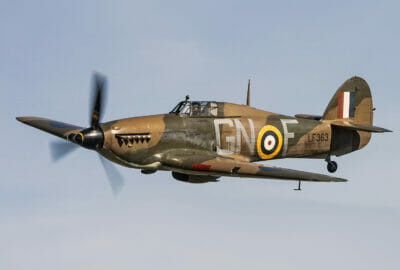

The Hawker Hurricane is an underappreciated British fighter plane of World War 2 that lived under the shadow of the more popular Supermarine Spitfire. It flew most of the sorties during the Battle of Britain, including firing the first shot in the conflict, and inflicted fifty-five percent of the total German losses. It had a low-wing cantilever design with an enclosed cockpit and a retractable undercarriage. The Hawker Hurricane airframe was built using traditional construction methods enabling easy repair and maintenance by ground crews on remote airstrips. The simple but rugged construction meant that pilots could fly heavily damaged Hawker Hurricanes back to base for repairs. Hurricanes were produced in the United Kingdom, Canada, Yugoslavia, and Belgium, with over fourteen-thousand units leaving the factory.
Hawker Hurricanes served in almost every major conflict theater of the Second World War, scoring numerous wins against its technically superior arch-enemy, the Messerschmitt Bf 109. It was used as part of the homeland defense operations, including operations on continental Europe, North Africa and the Mediterranean, the Baltics, SouthEast Asia, and the Soviet Union’s Eastern Front. The several variants of the Hurricane developed include catapult-launched Sea Hurricanes for the Royal Navy, bomber interceptors, photo-reconnaissance Hurricanes, Hurricane Tac R (Tactical reconnaissance), fighter-bombers, and night fighters.
Aircraft details
- Manufacturer – Hawker Aircraft
- Introduction – 1937
- Role – Fighter aircraft
- Configuration – Single-engine, one-seat
- Engine -1 x Rolls Royce Merlin XX V-12 liquid-cooled piston engine, 1,185 hp (884 kW) Speed – 550 kph (340 mph, 300 kn)
- Range – 970 km (600 mi, 520 nmi)
- No Built – 14,487
1. Supermarine Spitfire
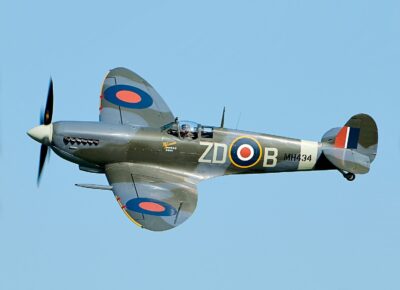

The Supermarine Spitfire captured the imagination of the entire United Kingdom more than other British fighter planes of World War 2. It is a single-engine fighter aircraft primarily used by the RAF during the war. It continues to be a wildly popular aircraft, with several Spitfires flying at airshows around the globe and hundreds on public displays at museums. Designed as a short-range fighter with elliptical wings producing optimum lift under any flying conditions, the Spitfire was the only British fighter plane that could duel on equal terms with the fearsome German Messerschmitt Bf 109.
Initially tasked with only engaging Bf 109s during the Battle of Britain, the Spitfire eventually replaced Hawker Hurricanes as the Royal Air Force Fighter Command’s primary workhorse. Spitfires served in the European, Mediterranean, Pacific, and South-East Asia conflict theatres, and several variants continued to be in service until the 1950s.
Aircraft details
- Manufacturer – Supermarine
- Introduction – 1938
- Role – Fighter/interceptor aircraft
- Configuration – Single-engine, one-seat
- Engine -1 x Rolls Royce Merlin 45 V-12 liquid-cooled piston engine, 1,470 hp (1,100 kW)
- Speed – 600 kph (370 mph, 320 kn)
- Range – 771 km (479 mi, 416 nmi)
- No Built – 20,351




















